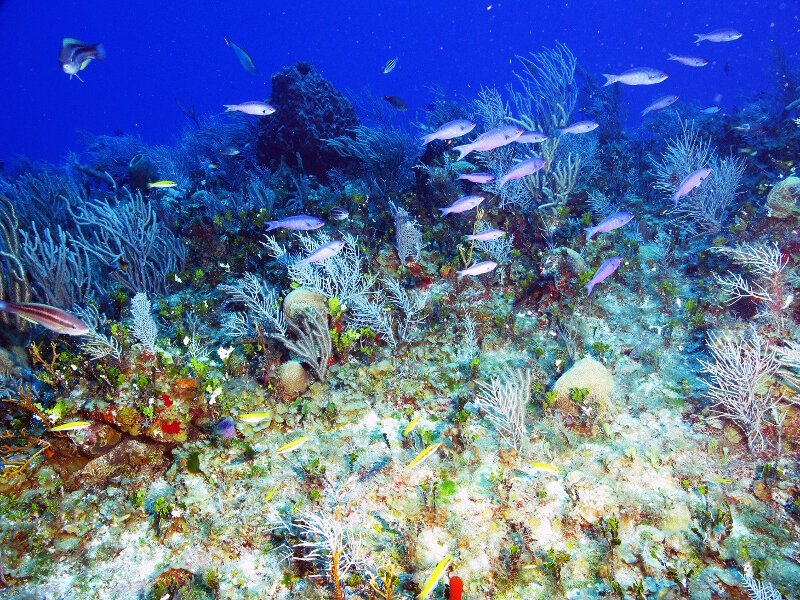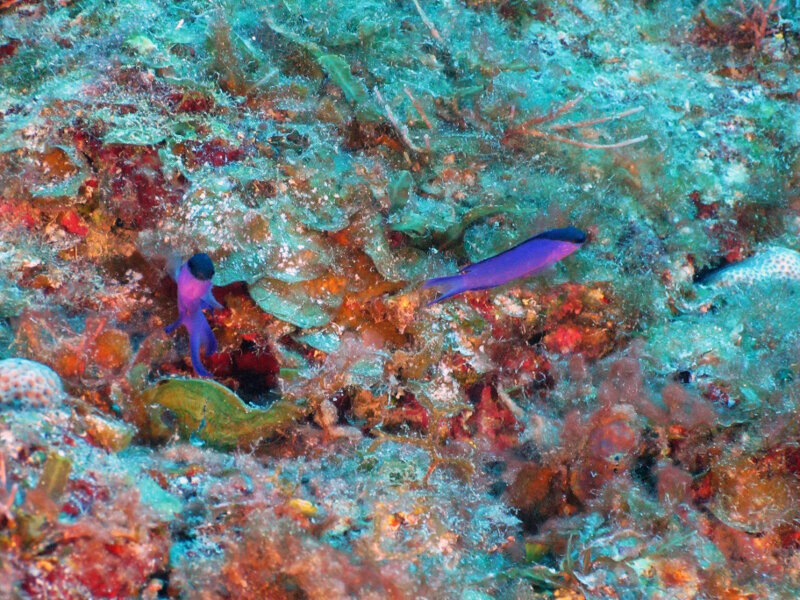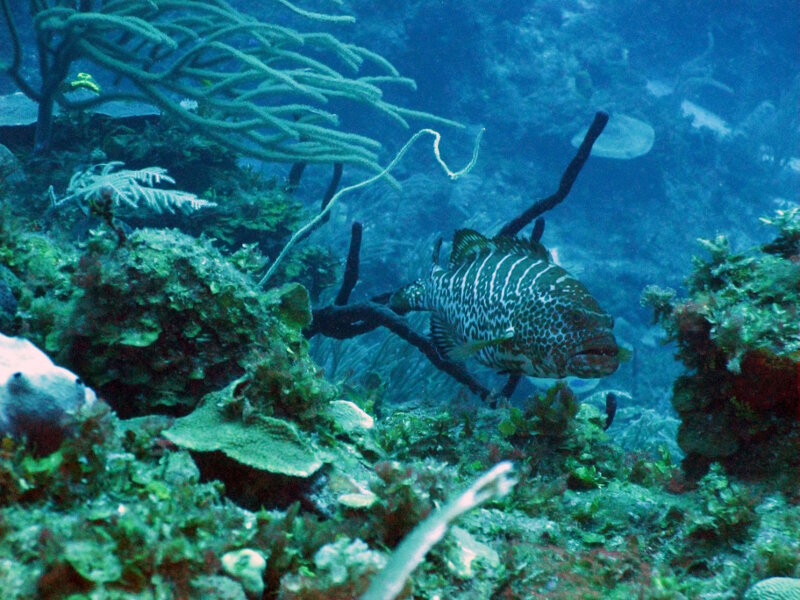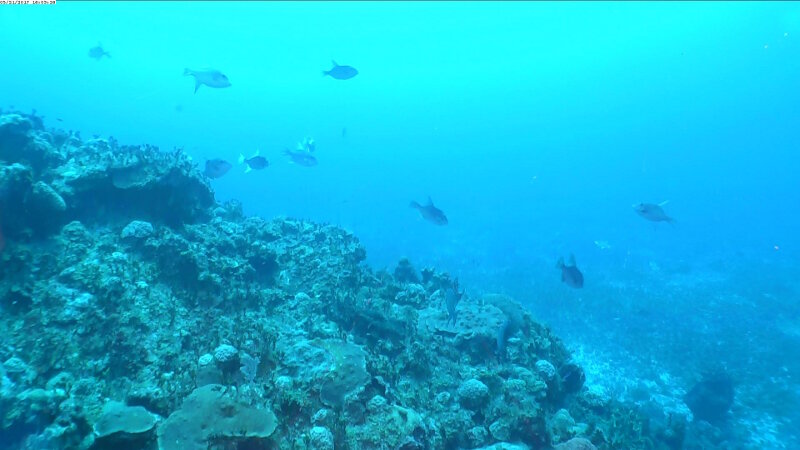
By Andy David, Research Fisheries Biologist - NOAA Fisheries
May 30, 2017

The number of species observed in Cuba’s mesophotic reefs is quite impressive. Image courtesy of Cuba’s Twilight Zone Reefs and Their Regional Connectivity. Download larger image (jpg, 1.0 MB).
During the first leg of the Cuba’s Twilight Zone Reefs Expedition, which included the western half of Cuba from Havana to Cienfuegos, we observed a very diverse group of fishes. In general, we expected to see larger numbers of fishes, but the number of species observed was very impressive.

The Blackcap Basslet (Gramma melacara), a small member of the grouper family, is very common in the deep mesophotic zone. Image courtesy of Cuba’s Twilight Zone Reefs and Their Regional Connectivity. Download larger version (jpg, 1.9 MB).
The deeper depths were dominated by a small member of the grouper family, the Blackcap Basslet (Gramma melacara). This is a small bright purple fish with, as its name implies, a black patch on the top of its head. Also common on deeper portions of the reefs were Blackfin Snapper (Lutjanus buccanella) and several species of Squirrelfish (Holocentridae).
On the upper portions of the reef walls we began to see Butterflyfish. Most often these were Longsnout Butterflyfish (Prognathodes aculeatus) and Foureye Butterflyfish (Chaetodon capistratus). Larger grouper began to be observed in this portion of the reef, including the Nassau Grouper (Epinephelus striatus), Tiger Grouper (Mycteroperca tigris), and Yellowfin Grouper (Mycteroperca venenosa). We often saw large schools of Jacks along the upper reef walls, particularly Black Jacks (Caranx lugubris) and Horse-eye Jacks (Caranx latus). Hiding in small nooks and crannies we saw one of the prettiest fishes of the cruise, the Cave Basslet (Liopropoma mowbrayi). Two noteworthy observations were Silk Snapper (Lutjanus vivanus) and French Butterflyfish (Prognathodes guyanensis).

The Tiger Grouper (Mycteroperca tigris) is one of several groupers we have seen on Cuba’s mesophotic reefs. Image courtesy of Cuba’s Twilight Zone Reefs and Their Regional Connectivity. Download larger version (jpg, 1.7 MB).
By far the largest numbers and greatest diversity of fishes were seen on the reef crests. Large schools of Schoolmaster Snapper (Lutjanus apodus), Mahogany Snapper (Lutjanus mahogoni), and Yellowtail Snapper (Ocyurus chrysurus) were common. Bar Jack (Caranx ruber), a small, fast moving predator often swam past the remotely operated vehicle (ROV). Several grouper species were also seen on the reef crests, including Black Grouper (Mycteroperca bonaci), Red Grouper (Epinephelus morio), Graysby (Cephalopholis cruentata), Red Hind (Epinephelus guttatus), and Coney (Cephalopholis fulva). The Red Grouper is very common in the southern United States but had only rarely been sighted in Cuba. Wrasses (Labridae), Damselfishes (Pomacentridae), and Parrotfishes (Scaridae) were present in large numbers on top of the reef walls. Along with Blue Tangs (Acanthurus coeruleus), the Parrotfishes helped keep the algae growth down which allowed the coral and sponges to flourish.

In our ROV transects along the upper reef walls, we often see large schools of Jacks, such as Horse-eye Jacks (Caranx latus). Image courtesy of Cuba’s Twilight Zone Reefs and Their Regional Connectivity. Download larger version (jpg, 1.4 MB).
The reef crest is also where the most colorful fishes were seen, including Queen Angelfish (Holacanthus ciliaris), Rock Beauty (Holacanthus tricolor), French Angelfish (Pomacanthus paru) and several species of Hamlet such as the Indigo (Hypoplectrus indigo), Shy (H. guttavarius) Barred (H. puella) Butter (H. unicolor) and Black (H. nigricans). Schools of grunts were seen on every dive, these were comprised mostly of French Grunt (Haemulon flavolineatum), Caesar (H. carbonarium), White (H. plumierii), Bluestriped (H. sciurus), and Cottonwick (H. melanurum). The largest schools of fishes were certainly the Creole Wrasse (Clepticus parrae) which were often seen in schools of several hundred.

Perhaps the most impressive fish observation from the first leg of the expedition was a spawning aggregation of Ocean Triggerfish (Canthidermis sufflamen). Image courtesy of Cuba’s Twilight Zone Reefs and Their Regional Connectivity. Download larger version (jpg, 297 KB).
Perhaps the most impressive observation from the first leg of Cuba’s Twilight Zone Reefs expedition was a spawning aggregation of Ocean Triggerfish (Canthidermis sufflamen). Hundreds of these fishes were seen just inshore of the reef crest making nests and courting partners. Like many fishes, these Triggerfish can change color very quickly and the ones in this aggregation were flashing between all black, all white, and several combinations in between.
The invasive lionfish (Pterois volitans/miles) was seen on almost all dives, but the numbers of them was considerably lower than we have seen in deep reefs off the United States. Lionfish are native to the western Pacific Ocean and have few natural predators in this hemisphere. This lack of predators coupled with their high birthrates allowed lionfish populations to dramatically increase in the United States. Fortunately, the lionfish population in Cuba remains relatively low; however, they were found at all depths we examined, from roughly 150 meters up to the top of the reef at 20 meters.